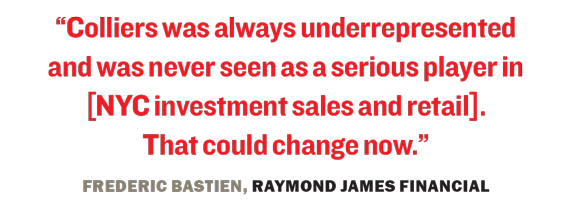Colliers International’s New York City office has never exactly been a selling point for the commercial brokerage.
Unlike many of its leading rivals — such as Cushman & Wakefield, CBRE, JLL and Eastdil Secured — the firm has had little to no presence in the competitive worlds of institutional investment sales and retail leasing in NYC.
While the Toronto-based company has 16,000 employees in 500 offices around the globe, standout Manhattan deals have been few and far between. That’s even after gobbling up smaller firms and going public in June 2015.
But heads turned late last year when Colliers wooed two star broker teams from their established gigs at other major firms: In November, it landed retail leasing aces Bradley Mendelson and David Green from Cushman, and the following month it poached JLL’s leading investment sales brokers Richard Baxter, Yoron Cohen and Scott Latham, who in turn brought over two more of their broker colleagues.
Now, with a bench of new and high-profile talent, many are expecting big things from the company in Manhattan.
“Colliers was always underrepresented and was never seen as a serious player in those areas,” said Frederic Bastien, an analyst at Raymond James Financial who follows the firm. “That could change now.”
 Several factors contributed to Colliers’ recent hires, including its relatively new autonomous status (it spun off from parent company FirstService Corporation less than two years ago) as well as New York’s ongoing market slowdown, which has created an increasingly unstable landscape for brokers. In addition, sources said Baxter, Cohen and Latham left JLL amid concerns that they were underperforming on big-ticket, institutional-level investment sales deals. A source close to the brokers vehemently denied that characterization, and Cohen filed a lawsuit against JLL after The Real Deal reported on it.
Several factors contributed to Colliers’ recent hires, including its relatively new autonomous status (it spun off from parent company FirstService Corporation less than two years ago) as well as New York’s ongoing market slowdown, which has created an increasingly unstable landscape for brokers. In addition, sources said Baxter, Cohen and Latham left JLL amid concerns that they were underperforming on big-ticket, institutional-level investment sales deals. A source close to the brokers vehemently denied that characterization, and Cohen filed a lawsuit against JLL after The Real Deal reported on it.
But one firm’s underperformers can be another’s meal ticket — depending on where the firm fits into the brokerage food chain.
The president of Colliers’ Eastern region, Joseph Harbert, for example, saw the JLL trio as a valuable asset that could increase the firm’s stature in the New York investment sales market. So he pounced.
“The press calls it poaching. I get these images of bodies lying in pools of water,” Harbert told TRD during a recent interview in Colliers’ New York office at 666 Fifth Avenue. “It’s really just tracking the hearts and minds of people with big careers and ascertaining when it’s time for them to move. I always know when people’s agreements are coming due.”
The question now is whether Colliers’ newest brokers will deliver. Harbert is betting they will. “I saw this [JLL] team as a great opportunity for Colliers to pick up known-quantity people that I’m comfortable with, that I know can pitch and win high-quality business,” he said.
Poaching plans
Harbert — a Ph.D. in political science who spent nearly a decade as a public-school teacher before getting into real estate in the 1980s — has big plans for Colliers’ NYC office.
The former Cushman chief operating officer has vowed to more than triple the size of both of the firm’s Manhattan retail leasing and investment sales operations from about a dozen brokers to 40 by the end of 2017.
The firm’s capital markets team — which brokers debt and equity, as well as outerborough institutional investment sales below $30 million — will grow to 25 brokers, while the retail team will increase to 15, he said.
Most of Colliers’ existing senior brokers in NYC focus on office leasing. According to a recent analysis of CoStar Group data, the firm inked 2.8 million square feet in Manhattan in 2016. While that’s far from shabby, it’s still nowhere near market leaders like CBRE, which leased 14.6 million square feet in 2016, and Cushman, which leased 5.8 million square feet.
 Meanwhile, in TRD’s most recent investment sales brokerage ranking (see related story on page 66), Colliers racked up only $27 million in sales across 10 deals and did not even make the top 40 — a massive fall from 2015 when it clocked in at No. 19 with $527 million across eight deals.
Meanwhile, in TRD’s most recent investment sales brokerage ranking (see related story on page 66), Colliers racked up only $27 million in sales across 10 deals and did not even make the top 40 — a massive fall from 2015 when it clocked in at No. 19 with $527 million across eight deals.
And in a December 2016 ranking of retail firms, it failed to crack the top 15.
While Colliers has two brokers specializing in retail-tenant representation, it has had zero game on the retail-landlord side.
Bringing on Mendelson and Green — best known for their Times Square deals, including the Gap and Old Navy’s lease at 1530 Broadway last year — was designed to get a foothold in that rarefied world.
Harbert conceded that Colliers (which also brought on Mendelson’s daughter Nicole) has been at a disadvantage when pitching to retail building owners.
The perception has been, “You could do the office leasing, but maybe you couldn’t do the retail,” Harbert said.
Corporate shakeup
Colliers International — and its predecessor companies — have undergone several major shakeups in New York over the past decade.
In 2008, Seattle-based FirstService acquired a 65 percent stake in the New York affiliate, then known as GVA Williams Real Estate. Then, in 2010, GVA Williams merged with FirstService and began operating under the Colliers brand.
(Colliers, which operates in 66 countries and generated $1.3 billion during the first three quarters of 2016, was itself founded in 1976 and merged with Canadian firm Macaulay Nicolls Maitland in the 1980s.)
Since the 2010 merger, Colliers executives have made clear their intentions to poach brokers.

Richard Baxter
In a TRD interview in 2011, Mark Jaccom, the then-CEO of the Colliers tri-state region, said the company would take advantage of the post-financial-crisis environment to ramp up hiring.
But in 2012, before his big poaching effort really got underway, Jaccom left to run smaller rival Cresa New York. A parade of brokers fled over the next few years, with many of them — including Richard Plehn, Vince Tuminelli, Peter Kozel and former New York Giants player Howard Cross — joining him at Cresa.
Harbert, who replaced Jaccom, said when he arrived, the agents were largely “legacy Williams brokers.” But he noted it’s not unusual for brokers to decamp when new leadership comes in.
“Sometimes when you’re creating a new culture, it’s not comfortable for people from the old culture,” he said. “A bunch of people who were here when I arrived aren’t here anymore.”
But Harbert has been steadily beefing up his ranks.
When the 70-year-old Queens native joined Colliers, there were 81 NYC brokers. Today there are 107, including longtime executives Michael Cohen, Andrew Roos and Robert Getreu, and high-level recruits Howard Grufferman and Marcus Rayner.
“Joe, who is not a broker, is more successful at recruiting than I was. My instincts are in brokerage,” said Jaccom, who recently stepped down as the head of Cresa’s New York office but is staying on as a vice chair in a broker capacity.
Still, some say Harbert has been financially hamstrung when it comes to recruiting — at least until now.
“The headquarters was not committing the funding to make big hires five years ago,” said one former Colliers executive, who asked to remain anonymous. “They weren’t ready to do it, but it appears now they are.”
Harbert has set his sights high, with attempts to lure several major brokers, including industry veteran and Cushman executive Bruce Mosler. Sources said Mosler repeatedly visited Colliers’ office a few years ago to negotiate terms with Harbert, but those negotiations ultimately fell apart. Harbert, who worked alongside Mosler at Cushman, confirmed the attempt, saying, “Of course, I tried to recruit Bruce. I did my best.”
Harbert said he has also courted the city’s top investment sales brokers, Doug Harmon and Adam Spies, separately, over the past four years. The duo stunned the industry in October when they left Eastdil and jumped to Cushman.
“Harbert made a big push to get a lot of stars, and you’d have to … offer a carrot big enough to feed them,” said Eric Meyer, a longtime Colliers broker who left last August with his father to focus on personal family holdings.
Investment sales shuffle
Commercial brokers generally jump between firms when the market is struggling, partly to ensure that they don’t leave any business on the table while transitioning.
Given the drop in momentum in the Manhattan market, it’s not all that surprising that 2016 saw a significant amount of broker reshuffling.

David Green
Harbert also cited Cushman’s 2014 purchase of Massey Knakal Realty Services and Harmon and Spies’ move to Cushman as two additional “destabilizing events” in the NYC broker landscape. Both have resulted in a heightened game of musical chairs in the investment sales world, said Harbert.
Harbert said he first approached the JLL team in June and began actively negotiating in the fall. But Baxter, Latham, Cohen and their colleague Jon Caplan — who joined JLL in 2010 after brokering blockbuster deals such as 666 Fifth Avenue, the MetLife Building and the Plaza Hotel — had fewer mega deals while at JLL than at Cushman. (Aside from representing Olayan Group and Chelsfield on their $1.4 billion Sony Building acquisition, JLL’s biggest NYC deal in 2016 was the $463 million sale of 850 Third Avenue.)
The brokerage ranked fifth in TRD‘s 2015 investment sales firm ranking, with $2.9 billion across 29 transactions. In 2016, the firm took fourth place with $3.2 billion across 11 deals, buoyed by the Sony Building transaction.
In the weeks since they left, two conflicting narratives have emerged about their
departure. While sources close to the brokers said JLL urged them to stay on, high-level executives at JLL told TRD the brokers were underperforming.
One top JLL source said that at a January 2016 meeting, the foursome was told that they were not doing enough to justify their lofty positions. The source said they were given an ultimatum in September: Step it up or leave at the end of the year, once their contracts expired. (Caplan left in late December with plans to start his own investment firm.)
A source close to the brokers, however, said the trio were offered a “substantial financial package to stay at JLL and opted for Colliers for better leadership.”
And Cohen’s lawsuit against JLL, which was filed after TRD reported on the allegedly unflattering version of the team’s departure, accused the firm of defamation. A spokesperson for JLL declined to comment.
Either way, the brokers were essentially free agents at the time of their move. When they arrived at JLL, they signed a five-year contract, which was renewed in 2015 but without a firm expiration date, Cohen said.
“We basically cruised and didn’t have a solid renewal,” he explained before filing his suit. “We were wide open.”
When asked why JLL did not provide a clear offer, Cohen said, “I really don’t know. Maybe they should’ve been more proactive. We loved JLL, and I say that not just for political reasons.”
At Colliers, Cohen and his colleagues — both on the investment sales and retail sides — can basically build their operations from scratch, Harbert said. But some insiders questioned why the firm opted for well-worn veterans rather than up-and-comers for that task.
“The JLL guys appear to be in the twilight of their career,” said Mitch Germain, an analyst at the investment bank JMP Securities, which trades Colliers shares on behalf of its clients.
Harbert — who was director of real estate for the Metropolitan Transportation Authority earlier in his career — overlapped with his new retail and investment sales
recruits at Cushman.
And although Colliers is not a New York leader, Germain and others noted that as a global player, it has resources.
“These guys have an ability to build something, roll up their sleeves and be entrepreneurs again,” Germain said. “They can set the next generation up.”
The endgame
After Colliers spun off from its parent company in 2015, the publicly traded brokerage announced plans to double its size by 2020. The plan was to acquire its affiliate companies and franchise offices.
Colliers has made good on that goal, snapping up several independent brokerages and six of its affiliates in the U.S.
But the spotlight is now squarely on New York — part of the firm’s Eastern region, which stretches from Washington, D.C., to Boston and, according to Harbert, generates $250 million in annual revenue.
In 2013, the company moved its national headquarters from Seattle to New York, where it had just opened a new 57,000-square-foot office at 666 Fifth. The space is a significant step up from the firm’s antiquated “rabbit warren” office at 380 Madison Avenue, said Harbert.
Colliers is now considering increasing its footprint in the high-profile tower by roughly 12,000 square feet — or opening a small Downtown office for the brokers actively doing lease deals in the area, Harbert said.
But industry sources have speculated that Colliers has an endgame. Some said it’s possible that the commercial brokerage could be sold to a major company in the next five years, though Harbert said there are no plans for that now.
“I’ve got to believe Colliers will either invest heavy dollars to become a CBRE, Cushman & Wakefield or a JLL, or get itself sold,” Jaccom said.
But whereas Cushman’s big investment sales push was part of its preparation for a proposed IPO, Colliers is already public.
“Cushman doesn’t need to be public — everyone knows who they are,” said veteran real estate industry analyst Brandon Dobell, a partner at the global investment bank William Blair & Co. “With Colliers, there’s a clear initiative to get it to be twice as big. They’re adding heads in the U.S., where they’re sub-scale relative to the big companies.”
For now, Harbert is wary of becoming too big, noting that giant firms often end up creating bureaucratic silos that stymie brokers.
“If we got to be 300 brokers [in New York] like CBRE, then we’d have some of the same issues that come with size.”
